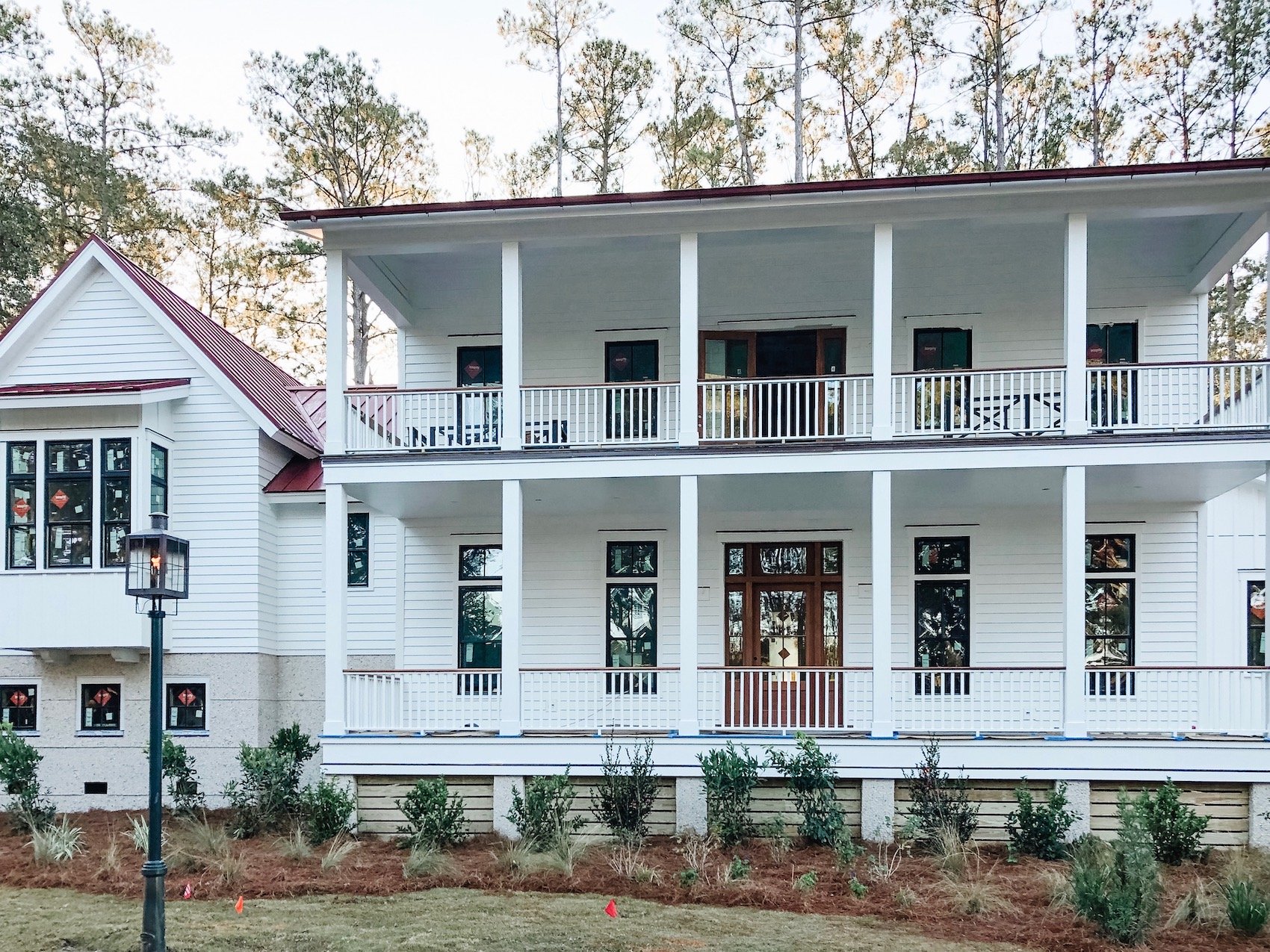
Every house in the South worth its salt has to have an outside space. Code says that if that outside space is elevated, it needs a functional railing. Yet how many times have you seen railings begin to rot and disintegrate after only a few years? What separates a good builder from the crowd is often those small little actions, that attention to detail that often goes unnoticed amongst the more substantial actions on a construction project.
As our custom home building in Palmetto Bluff progresses, we are keenly aware of the joinery and connections that invite water to infiltrate wood. Water is the enemy of a wooden home. Water enables the existence of molds, fungus, and insect attacks. A wooden house in Timbuktu, Mali may erode from blown sand, but it will never rot. A wooden house in a location like Bluffton, South Carolina is under constant attack. Liquid water, humidity, heat, expansion and contraction. These are all the death knell of your home unless you (your builder) take a few detail steps during construction to make it last. So let us examine just one such aspect –
railings. With the popularity of the Charleston Single style home
and it’s classic piazzas, and the lowcountry’s often elevated building heights, outdoor porches and railings are a common and popular part of the overall design.
In its simplest form, a railing is simply a top and bottom rail separated by pickets and kept vertical by posts on both sides. They are usually made of wood with rails and pickets of various styles and designs. Wood is a plant, to press the point, and we have basically made a railing from dried vegetation and now hope it will last, even though it is constantly wet. It won’t, so best keep it as dry as possible.
The first and perhaps worst mistake we often see is the use of timber in outdoor areas that has not been chemically pre-treated. Plain old cheap timber will look great for a season or so and then turn rapidly into the building equivalent of compost. Treated timber can come as the “green stained damp stuff ” you buy at the lumber yard, or Kiln Dried And Treated (KDAT). Both work just as well, though KDAT is more stable and better for good carpentry. Undoubtedly, water will get into the wood somewhere, so best make it a difficult environment for rot to get a foothold. Modern treatments are often copper-based and quite harmless to the more “evolved ” organisms which may occupy your home.
The second mistake we see is a contractor that will use galvanized brad nails in a coastal setting. Good for maybe ten years or so, but then you will need new railings as the protection offered by a thin galvanized layer is exhausted and the brads begin to corrode. If the brads can be kept dry they will last longer but will still eventually fail.
Use either Stainless Steel nails for the most exposed areas or, mechanically lock the pickets into place as our Victorian ancestors did for all those historic homes. When initially constructed, it is near impossible to tell the difference – average builder vs. good builder – remember?
Next is to live with the forlorn hope that water drains horizontally. It does not unless you are on a rolling boat. So every horizontal surface becomes a water trap, exactly where the joints between rail and picket exist on the railing. It’s an easy fix to add a 10-degree taper to the surface of a lower rail during construction. Our crews did just that, two passes through a table saw, and the profile is set on both edges. If your pickets are set into a dado (carpentry term for a deep square groove), then make sure they are bedded in caulking to prevent water from accumulating in that dado in future years.
You can add a taper to a top rail, but it is not a great look. A better effect is to use a capping rail. This is slightly wider than the top rail and acts as both protection and to keep the water off. Its often made from decking lumber, and here is the next error. Water hits the capping, wicks down and under it then rots the top rail. In a custom build project such as this, it is far better to either buy a capping rail that fits over the top rail, covering the upper edge or, to route one out on-site from materials on hand. We seal the underside during assembly and have not seen issues when we use this construction method. Well-fitted capping rails add elegance to the final product. (Note: you will also need an additional grab rail for stairways to meet code, on the side or on top of the capping rail.)
And our last water culprit? Gutters. Many Charleston homes do not use gutters, so the water pours off the roof and all over that beautiful piazza and those new railings. Keeping your railings temporarily underwater does not promote longevity. Give your building some love and fit an appropriate gutter system at least over areas that would benefit from being dry.
Understanding the unique challenges that come with building in the lowcountry climate and the necessary steps to be taken during construction are essential to creating a home that will stand the test of time. Managing water as it relates to building materials and the fortitude of the final structure is key in an area of the country like Charleston, SC where the elements include high humidity, tropical storm rains and the occasional hurricane. Let us help you create your dream home or investment asset by building and share with you our commitment to getting every little detail right.
Click on previous blogs below to follow the series along from the beginning:
Next Post >
 Every house in the South worth its salt has to have an outside space. Code says that if that outside space is elevated, it needs a functional railing. Yet how many times have you seen railings begin to rot and disintegrate after only a few years? What separates a good builder from the crowd is often those small little actions, that attention to detail that often goes unnoticed amongst the more substantial actions on a construction project.
Every house in the South worth its salt has to have an outside space. Code says that if that outside space is elevated, it needs a functional railing. Yet how many times have you seen railings begin to rot and disintegrate after only a few years? What separates a good builder from the crowd is often those small little actions, that attention to detail that often goes unnoticed amongst the more substantial actions on a construction project. 
